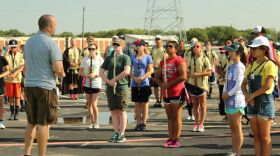Students at Bowie High School in Arlington are learning how to fix band instruments. It might be the first high school program of its kind in the country.
No, this isn’t band camp. Or band class. Or even a rehearsal. It's instrument repair class.
Instructor Joe Strohl shows off a silver baritone.
“It’s been around a long time,” Strohl says. “And, honestly, we’ve done quite a bit of repair. This is actually one of our demo horns that we get to do this sort of thing on.”
Strohl hands a visitor a hammer. He whacks it. Twice. Then one more time.
Sometimes, you've got to take a hammer to a horn to fix it.
Strohl says brass dents are the most common instrument repairs. They’re done here on purpose so students can learn how to fix them.
No high-tech substitute for instrument repair
We’re in the old photography dark room at Bowie. Digital cameras made it extinct. But instrument repair – there’s no high-tech substitute.
Strohl’s been fixing everything from bassoons to sousaphones for two decades. He works for Music & Arts, the giant band instrument repair and retail business. He’s only been in the classroom for three months in this partnership between the company and the district.
Strohl has seen his share of bashed horns, like a teen’s trombone brought in by a mom.
“She picked it up off the bed, stuck it up in the air and the trombone slide caught in the ceiling fan and just bent it into a 90-degree angle,” Strohl says. “That was a new experience.”
Shaping instrument parts and soldering with flame
This class is a new experience for 17-year-old Noah Patrick, a senior at Lamar High. Every other day he rides a bus to Bowie for the class. For Noah, it hit the right note. He was hard up for options after graduating.
“Honestly, school’s just not really my thing,” Noah says. “I’ve always kind of liked building stuff and putting it together. Since I love music … I figured: Why not do this?”
Noah’s learning to machine and shape small instrument parts. He’s learning how to solder with flame.
In the wet room across the hall, he’s shown lacquer and buffing techniques that’ll leave fixed instruments with a high gloss. If he continues, Noah can enroll as a summer intern at Music and Arts' 2,500-square foot Dallas repair shop.
An aging instrument repair workforce
“It’s like blacksmithing and it takes a number of years,” Jeremy Earnhart says. He’s the fine arts director for the Arlington school district. He's a trumpet player, and he’s had this idea for years.
“After two years, our students will be apprenticeship-ready, and that’s about a $15-an-hour job,” Earnhart says.
Two years after that, Earnhart says they’ll be ready to make up to $70,000 a year.
Vince Chiappone, Texas sales director with Music & Arts, remembers Earnhart’s call a few years back pitching the idea.
“If Jeremy calls, I pick up the phone,” Chiappone says, smiling. “And my wheels really started turning right away thinking about our team of repair people is aging. And they’re not being replaced as quickly as we are growing. This would give us a platform to be able to create our own repair techs.”

Giving a horn a new life
Back in the Bowie repair room, it’s time to fix the horn that was hammered.
Strohl pulled out a smooth steel ball and handed over a powerful magnet.
“Put the ball in,” Strohl says. "Then take your magnet. There we go.”
The magnet outside the horn rolls the ball inside back and forth across the dent until it’s nearly smooth.
Seven students signed up for this very first band repair class.
The goal is to get a dozen apprentice-ready techs a year, Earnhart says. And, for the horn, another life.
KERA’s American Graduate initiative follows the journey from childhood to graduation.






